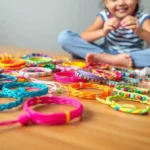Relationships can feel like a wild rollercoaster ride—thrilling, confusing, and sometimes downright dizzying. Navigating the ups and downs of love, friendship, and family ties isn’t just an art; it’s a full-time job that often comes with no instruction manual. Whether it’s deciphering the mysterious language of love or figuring out why your friend suddenly ghosted you, understanding relationships can be a real conundrum.
But fear not! This guide aims to unravel the complexities of human connections with a sprinkle of humor and a dash of insight. From the sweet moments to the awkward encounters, he’ll explore the essential elements that make relationships tick. So grab a cup of coffee and get ready to dive into the delightful chaos of understanding relationships—because who doesn’t want to master the fine art of human interaction?
Table of Contents
ToggleUnderstanding Relationships: An Overview
Relationships encompass various forms of connections, including romantic partnerships, friendships, and familial bonds. They constitute essential aspects of human life, significantly influencing well-being and emotional health. Navigating these connections often involves complexities, such as differing communication styles and individual expectations.
In romantic relationships, understanding each partner’s love language enhances communication and strengthens emotional bonds. Examples of love languages include acts of service, words of affirmation, and physical touch. Recognizing these preferences ensures partners feel valued and appreciated, fostering deeper intimacy.
Friendships play a critical role in social support systems. Trust, respect, and shared interests form the foundation of lasting friendships. Engaging in regular activities together, like exploring hobbies or attending events, promotes connection and strengthens ties.
Familial relationships often require balance and compromise. Respecting boundaries and acknowledging individual differences contributes to healthier family dynamics. Creating open lines of communication allows family members to express concerns and resolve conflicts effectively.
Overall, understanding the nuances of relationships involves recognizing the individual needs and desires of all parties involved. Relationship satisfaction often stems from mutual respect and appreciation. Developing key skills, such as active listening and empathy, further promotes healthy interactions.
Addressing challenges in relationships requires patience and effort. Continuous growth and adaptation help relationships evolve positively over time. This ongoing commitment leads to fulfilling connections, enriching lives and providing lasting support through life’s ups and downs.
Key Components of Healthy Relationships



Understanding the key components of healthy relationships helps build strong connections. These elements create a foundation for mutual respect and satisfaction.
Communication
Open communication fosters connection. Sharing thoughts and feelings openly enhances understanding. Listening actively to one another encourages deeper intimacy. Discussing issues directly prevents misunderstandings and resentment. Nonverbal signals also play a role; body language can convey emotions. Regular check-ins about feelings and expectations strengthen bonds. Aiming for clarity in conversations reduces confusion and builds trust. Practicing empathy during discussions supports a safe environment for sharing. Overall, effective communication minimizes barriers and enhances relationship quality.
Trust and Honesty
Trust and honesty serve as cornerstones for lasting relationships. Establishing trust takes time and requires consistent actions. Being reliable and keeping promises cultivates trustworthiness. Honesty in expressing feelings and intentions prevents deception. Openly discussing mistakes and vulnerabilities builds deeper connections. Transparency encourages partners to be vulnerable without fear of judgment. Trust allows individuals to feel secure in their relationships and makes conflict resolution easier. Fostering an atmosphere of honesty generates mutual respect. Acknowledging and addressing issues promptly maintains trust and strengthens the overall relationship dynamic.
Common Challenges in Relationships
Relationships often encounter various challenges that can create friction. Understanding these issues contributes to healthier connections.
Miscommunication
Miscommunication frequently arises from assumptions and misunderstandings. It creates barriers between partners, leading to frustration and resentment. Clear articulation of thoughts and feelings plays a significant role in decreasing confusion. Active listening helps individuals grasp the intended message while minimizing misinterpretations. Nonverbal cues, including body language and tone, also impact communication effectiveness. Addressing potential misunderstandings promptly prevents minor issues from escalating. Overall, prioritizing open dialogue fosters a more supportive atmosphere and enhances relational dynamics.
Differing Expectations
Differing expectations may surface in any type of relationship. Individuals often arrive with unique backgrounds and beliefs, which influences their perspectives. Clarity about personal desires and objectives cultivates understanding between partners. When one partner anticipates a particular outcome, and the other has different views, conflict can occur. Aligning expectations requires honest discussions and willingness to compromise. Recognizing each person’s needs strengthens the foundation of the relationship. Prioritizing shared goals leads to a more harmonious connection and helps navigate challenges effectively.
The Role of Emotional Intelligence
Emotional intelligence plays a pivotal role in the success of relationships. It involves understanding one’s own emotions and recognizing the feelings of others.
Self-Awareness
Self-awareness serves as the foundation for emotional intelligence. Knowing personal emotions helps individuals communicate effectively. Recognizing triggers enables better management of reactions. This understanding also fosters growth in relationships, as it encourages individuals to reflect on their behaviors. Being conscious of one’s feelings leads to authentic interactions with others. Individuals who embrace self-awareness can navigate complex situations more gracefully and respond thoughtfully rather than impulsively.
Empathy and Understanding
Empathy enhances emotional connections among people. Demonstrating empathy involves actively listening and validating others’ feelings. This understanding creates a safe space for open dialogue, allowing for deeper connections. Practicing empathy leads to stronger bonds and mutual respect. Individuals often find that empathizing with friends, family, and partners cultivates a more supportive environment. This connection not only nurtures relationships but also aids in resolving conflicts more amicably. People with high levels of empathy better appreciate diverse perspectives, fostering harmony in their interactions.








